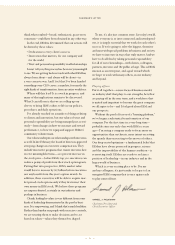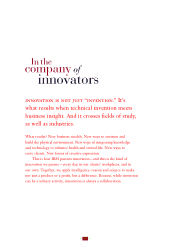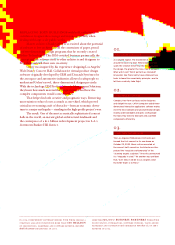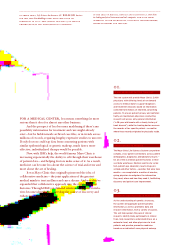IBM 2003 Annual Report Download - page 21
Download and view the complete annual report
Please find page 21 of the 2003 IBM annual report below. You can navigate through the pages in the report by either clicking on the pages listed below, or by using the keyword search tool below to find specific information within the annual report.
19
“With the many ills the airline industry faces today,
and in a highly logistical business, managing processes
by applying technology more widely
and more innovatively is a necessity.”
EERO AHOLA, SENIOR VICE PRESIDENT, CORPORATE BUSINESS
DEVELOPMENT AND STRATEGY, FINNAIR
Finnair
higher math
what are an airline’s assets, and how do they gener-
ate revenue? There are the fleet and routes, of course—but there is
also a vast and continually growing store of data about travel and
purchase histories. The problem is, this asset has been essentially
unused. But what if that data could be analyzed and integrated with
marketing programs and processes to predict buying patterns and
sales appeal? Customer relationship management would then
become customer equity management. And that would be a whole
new way to run an airline.
That’s how Finnair’s long-term relationship with IBM took a
new turn this past year, with the deployment of mathematical mod-
eling and optimization algorithms designed by researchers from
IBM’s Zurich Research Lab. Processing frequent-flier data has a
potential impact of reducing marketing costs by 20 percent while
improving marketing response rates by as much as 10 percent. And
that means big money—in increased revenues and in savings.
Still only a prototype, IBM’s Customer Equity Management
solution already has an 80 percent accuracy rate for predicting the
eventual value a customer represents. By forecasting a frequent
flier’s future travel decisions, it’s also helped improve the airline’s
customer satisfaction rate by 10 percent. And all from pulling
numbers out of Finnair.
ibm has been working with the airline industry since the
1960s. Today, 18 of the world’s top 20 airlines are ibm clients,
including delta air lines, air canada, japan airlines and
american airlines.
01.
OTHER DESTINATIONS
Finnair now uses IBM’s Customer Equity
Management system to understand its best
customers much more deeply, and to tailor
marketing programs to them—even aligning
company strategy around their needs. And future
applications could be broader still—helping make
decisions about fleet deployment, the allocation
of new routes, and contingency plans for some of
the most serious challenges facing airlines today.
02.
GETTING UPGRADED
Finnair’s relationship with IBM began decades
ago, in the mainframe era. Since 2002, IBM has
run the airline’s data center operations, as well.
But with Customer Equity Management, IBM
and Finnair are taking a whole new trip together.
“They’ve gone from being a supplier to being our
data center to being a partner,” says Eero Ahola.
“It’s a totally different relationship.”
























